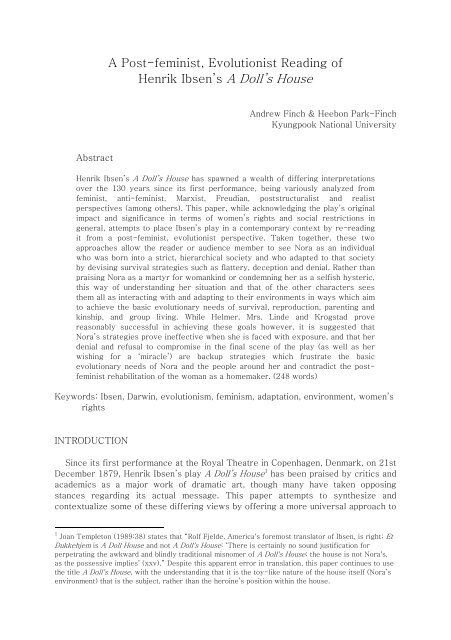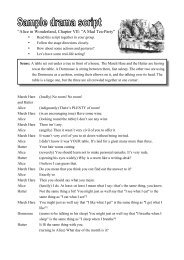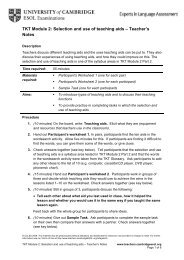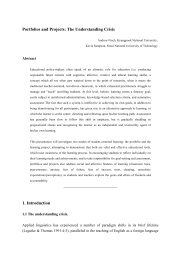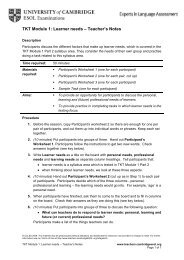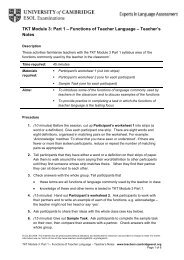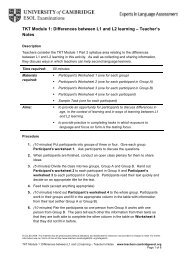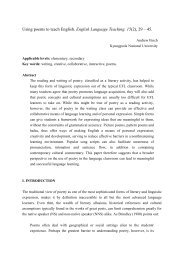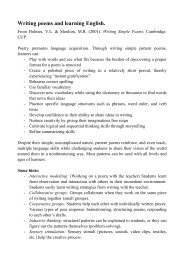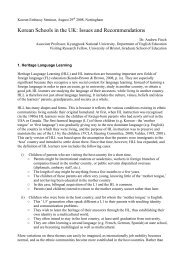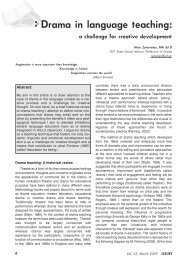A Post-feminist, Evolutionist Reading of Henrik Ibsen's A ... - Finchpark
A Post-feminist, Evolutionist Reading of Henrik Ibsen's A ... - Finchpark
A Post-feminist, Evolutionist Reading of Henrik Ibsen's A ... - Finchpark
- No tags were found...
You also want an ePaper? Increase the reach of your titles
YUMPU automatically turns print PDFs into web optimized ePapers that Google loves.
A <strong>Post</strong>-<strong>feminist</strong>, <strong>Evolutionist</strong> <strong>Reading</strong> <strong>of</strong><strong>Henrik</strong> Ibsen’s A Doll’s HouseAndrew Finch & Heebon Park-FinchKyungpook National UniversityAbstract<strong>Henrik</strong> Ibsen’s A Doll’s House has spawned a wealth <strong>of</strong> differing interpretationsover the 130 years since its first performance, being variously analyzed from<strong>feminist</strong>, anti-<strong>feminist</strong>, Marxist, Freudian, poststructuralist and realistperspectives (among others). This paper, while acknowledging the play’s originalimpact and significance in terms <strong>of</strong> women’s rights and social restrictions ingeneral, attempts to place Ibsen’s play in a contemporary context by re-readingit from a post-<strong>feminist</strong>, evolutionist perspective. Taken together, these twoapproaches allow the reader or audience member to see Nora as an individualwho was born into a strict, hierarchical society and who adapted to that societyby devising survival strategies such as flattery, deception and denial. Rather thanpraising Nora as a martyr for womankind or condemning her as a selfish hysteric,this way <strong>of</strong> understanding her situation and that <strong>of</strong> the other characters seesthem all as interacting with and adapting to their environments in ways which aimto achieve the basic evolutionary needs <strong>of</strong> survival, reproduction, parenting andkinship, and group living. While Helmer, Mrs. Linde and Krogstad provereasonably successful in achieving these goals however, it is suggested thatNora’s strategies prove ineffective when she is faced with exposure, and that herdenial and refusal to compromise in the final scene <strong>of</strong> the play (as well as herwishing for a ‘miracle’) are backup strategies which frustrate the basicevolutionary needs <strong>of</strong> Nora and the people around her and contradict the post<strong>feminist</strong>rehabilitation <strong>of</strong> the woman as a homemaker. (248 words)Keywords: Ibsen, Darwin, evolutionism, feminism, adaptation, environment, women’srightsINTRODUCTIONSince its first performance at the Royal Theatre in Copenhagen, Denmark, on 21stDecember 1879, <strong>Henrik</strong> Ibsen’s play A Doll’s House 1 has been praised by critics andacademics as a major work <strong>of</strong> dramatic art, though many have taken opposingstances regarding its actual message. This paper attempts to synthesize andcontextualize some <strong>of</strong> these differing views by <strong>of</strong>fering a more universal approach to1 Joan Templeton (1989:38) states that “Rolf Fjelde, America's foremost translator <strong>of</strong> Ibsen, is right; EtDukkehjem is A Doll House and not A Doll's House: ‘There is certainly no sound justification forperpetrating the awkward and blindly traditional misnomer <strong>of</strong> A Doll's House; the house is not Nora's,as the possessive implies’ (xxv).” Despite this apparent error in translation, this paper continues to usethe title A Doll's House, with the understanding that it is the toy-like nature <strong>of</strong> the house itself (Nora’senvironment) that is the subject, rather than the heroine’s position within the house.
the text, while reconsidering women’s-rights aspects <strong>of</strong> the play in the light <strong>of</strong>contemporary, post-<strong>feminist</strong> views <strong>of</strong> the role <strong>of</strong> women in society and thusreappraising the meaning and significance <strong>of</strong> the play for 21st century audiences.The original ideas for this paper came to the authors while watching the PeterHall production <strong>of</strong> A Doll’s House at the Theatre Royal, in Bath (UK), in the summer<strong>of</strong> 2008. Expecting to see Nora depicted as a repressed woman who finally freesherself from unbearable personal and social restrictions and breaks from her familyin order to discover who she really is, we were presented instead with a rathervolatile and progressively more unstable character, who seemed to take pleasure indeceiving her husband and those around her. This interpretation inspired us to thinkdeeply about the text and its social and historical context and to re-read it in thelight <strong>of</strong> contemporary critical approaches, in particular post-feminism andevolutionism. In this context, it is interesting to note that Charles Darwin’s On theOrigin <strong>of</strong> the Species, which is considered to be the foundation <strong>of</strong> evolutionarybiology, and which is at the heart <strong>of</strong> literary evolutionary theory, was published in aSwedish translation in 1869 and in Danish in 1872, seven years before A Doll’sHouse was first performed.Audiences and critics were enthusiastic about Ibsen’s new stage play when itopened, though his agent in Germany expressed misgivings about the ending 2 . Thiswas a time <strong>of</strong> intellectual and social turbulence and revolution in Europe; the Danishtranslation by Georg Brandes <strong>of</strong> John Stuart Mill’s The Subjection <strong>of</strong> Women hadappeared in 1869 and Mill and Ibsen described the social and moral suffering causedto men and women by the prevailing inflexible patriarchy. From this perspective,women’s issues were symptomatic <strong>of</strong> society’s problems, which were highlighted byIbsen “through individual destinies and confrontations” (Hemmer, 1994:82). Thisdual focus allowed young movements such as Socialism, Marxism and Feminism toclaim Ibsen as their spokesman, as evidenced by the famous stage reading <strong>of</strong> ADoll’s House that took place on 15th January 1886, in Great Russell Street, London,in the rented flat <strong>of</strong> Karl Marx’s youngest daughter, Eleanor 3 (Nora) and hercommon-law husband, Edward Aveling (Helmer). Bernard Shaw played Krogstad andWilliam Morris’s daughter May, played Mrs. Linde (Kelly, 2004:539). A “plethora <strong>of</strong>‘isms’” (Aestheticism, Fabianism, Socialism, Marxism and Feminism) were thus allrepresented at this evening, which has been described as “an auspicious one for‘Ibsenism’ (Durbach, 1994:233). It is not surprising that A Doll’s House was soonknown as ‘the fist <strong>feminist</strong> play’, an interpretation echoed by Joan Templeton (1989),who points out that Ibsen was very much involved with women’s rights at that time,and was actively communicating with three influential <strong>feminist</strong>s:A Doll House is a natural development <strong>of</strong> the play Ibsen had just written, theunabashedly <strong>feminist</strong> Pillars <strong>of</strong> Society; both plays reflect <strong>Ibsen's</strong> extremelyprivileged <strong>feminist</strong> education, which he shared with few other nineteenthcenturymale authors and which he owed to a trio <strong>of</strong> extraordinary women:Suzannah Thoresen Ibsen, his wife; Magdalen Thoresen, his colleague at the2 These misgivings led to Ibsen being forced to supply an alternative ending, which he later called a“barbaric act <strong>of</strong> violence” towards the play (Open letter to the Danish newspaper Nationaltidende, dated17 February 1880).3 Coincidentally, “Ibsen was fond <strong>of</strong> explaining that his heroine's "real" name was "Eleanora" but thatshe had been called "Nora" from childhood” (Templeton, 1989: 35).
Norwegian National Theatre in Bergen, who was Suzannah's stepmother andformer governess; and Camilla Wergeland Collett, <strong>Ibsen's</strong> literary colleague,valued friend, and the founder <strong>of</strong> Norwegian feminism. (Templeton, 1989:36)Egil Törnqvist also cites these relationships, stating that, “It was presumably afterbecoming acquainted with the Norwegian <strong>feminist</strong> writer Camilla Collett in 1871 thatIbsen became deeply concerned with issues pertaining to man-woman relationshipsin contemporary society” (1995:4), further referring to Ibsen’s Notes for TheTragedy <strong>of</strong> Modern Times (Meyer, 2005:476) as being concerned with “howfeminine nature (instinct) is pitted against masculine regulative thinking (culture).The ethics <strong>of</strong> the suppressed female are opposed to those <strong>of</strong> the suppressing male”(1995:8). Continuing in this vein, Joan Templeton (1997), writing about the women inIbsen’s plays, sees A Doll’s House as:… Ibsen’s most explicit treatment <strong>of</strong> the women question. The conflict isbetween society’s demand that Nora embrace the women’s role that it hasdetermined for her – “Before all else, you’re a wife and mother” – and herrefusal in the name <strong>of</strong> her own autonomy: “I believe that, before all else, I’m ahuman being”. Nora does not leave the doll house to find some other role insociety, but, on the contrary, to discover the self she refused in living a role.(325)Ibsen himself commented famously that:A woman cannot be herself in modern society. It’s an exclusively male society,with laws made by men and with prosecutors and judges who assess feminineconduct from a masculine standpoint. (Meyer, 2005:476)From the opposite perspective, commentators such as Ibsen’s biographer, M.Meyer and others, dismiss Nora as “an irrational and frivolous narcissist; an"abnormal" woman, a "hysteric"; a vain, unloving egoist who abandons her family in aparoxysm <strong>of</strong> selfishness” (Templeton, 1989:29), laying great emphasis on Ibsen’swords in a speech given to the Norwegian Women's Rights League in 1898, when heinsisted that he "must disclaim the honor <strong>of</strong> having consciously worked for thewomen's rights movement," and that he wrote his plays "without any consciousthought <strong>of</strong> making propaganda," his task being "the description <strong>of</strong> humanity" (Ibsen,1898). Other interpretations see Nora as representative <strong>of</strong> Everyman rather thanwomen in particular (cf. Durbach, 1994:234), while Hermann Wiegand goes so far asto classify A Doll’s House as a comedy (1925:68).Whatever the view taken <strong>of</strong> Nora’s actions and the overall message <strong>of</strong> the play, itis generally accepted that it describes the social, emotional, and spiritual restrictionsimposed on women by Norwegian society <strong>of</strong> the late 19 th century and that part <strong>of</strong>Nora’s battle (whether personal or symbolic) is to become aware <strong>of</strong> theserestrictions and to confront the artificial environment which had been created aroundher. In this context, Alexander Herzen (writing in 1868) had identified the issuesinvolved in My Past and Thoughts:
A sober view <strong>of</strong> human relationships is far harder for women than for us; […]they are more deceived by education and know less <strong>of</strong> life, and so they more<strong>of</strong>ten stumble and break their heads and hearts than free themselves. They arealways in revolt, and remain in slavery; they strive for revolution and more thananything they support the existing regime. (1982: 439)More tellingly, Herzen goes on to describe, in words that might well be applied toNora and to Mrs. Linde, the effort <strong>of</strong> awareness needed by women if they were toextricate themselves from this vicious circle:For a woman to extricate herself from this chaos is an heroic feat: only rare andexceptional natures accomplish it; the other women are tortured, and if they donot go out <strong>of</strong> their minds it is only thanks to the frivolity with which we all livewithout over-subtlety in the face <strong>of</strong> menacing blows and collisions, thoughtlesslypassing from day to day, […] and from contradiction to contradiction. (1982: 439)It could be claimed that these two excerpts exhibit a rather condescending andpatriarchal attempt at objectivity in their ‘them and us’ approach, and that they werewritten by someone who was part <strong>of</strong> the problem rather than the solution (Herzen’slife was marred by a number <strong>of</strong> domestic tragedies and extra-marital affairs), butthey do at least highlight the sort <strong>of</strong> issues that led to the appearance <strong>of</strong> first-wavefeminism at the end <strong>of</strong> the 19 th century and the beginning <strong>of</strong> the 20 th century.FEMINISMGail Finney points out that A Doll’s House “was enthusiastically welcomed by<strong>feminist</strong> thinkers in Norway and throughout Europe” and states that, “In closing thedoor on her husband and children, Nora opened the way to the turn-<strong>of</strong>-the-centurywomen’s movement” (91). Matinee performances <strong>of</strong> Ibsen’s plays in London between1880 and 1900 4 were overwhelmingly attended by women, who “had assembled inforce to do honour 5 to the Master who headed the revolt <strong>of</strong> her sex” (Barstow 387).Thus, in the stage reading in Bloomsbury in 1886, the ‘miracle <strong>of</strong> miracles’ forEleanor Marx was “Marxist change with its promise <strong>of</strong> economic and intellectualemancipation for women and workers alike; and Nora’s predicament read as ametaphor for the exploitation and oppression <strong>of</strong> labour” (Durbach 234).Unfortunately, Eleanor’s own doll’s-house existence imploded in 1898 when herpartner, who was a founder <strong>of</strong> The Socialist League, a spokesman for Darwinianevolution and co-translator <strong>of</strong> Volume I <strong>of</strong> Marx’s Das Kapital, was found to be abigamist and deeply in debt. Nonetheless, Durbach identifies Eleanor Marx as thefirst <strong>of</strong> Ibsen’s <strong>feminist</strong> critics, classifying her Socialist Feminism (which continues inthe work <strong>of</strong> contemporary dramatists such as Caryl Churchill) as class-based ratherthan gender-based, in contrast to Bourgeois Feminists, who call for political,economic and social parity, and Radical Feminists, who insist on irreconcilable4 “Of the Ibsen plays premiered in London between 1880 and 1900, all but three were originallyproduced as matinees, and male reviewers <strong>of</strong>ten found themselves in an unaccustomed anduncomfortable minority” (Barstow, 2001: 387).5Quotations in this paper preserve the original spelling.
conflict between male and female. This first-wave feminism was exemplified in the19th century literary phenomenon <strong>of</strong> “The New Woman”, a type <strong>of</strong> heroine whochallenged the restrictions set by male-dominated society and valued self-fulfillmentand independence rather than the traditional ideal <strong>of</strong> self-sacrifice (Finney 95).Ibsen’s plays A Doll's House (1879) and Hedda Gabler (1890) foregrounded suchNew Women (cf. Max Beerbohm’s apocryphal joke that, "The New Woman sprangfully armed from <strong>Ibsen's</strong> brain"), as did Henry Arthur Jones's The Case <strong>of</strong> RebelliousSusan (1894) and George Bernard Shaw's controversial Mrs. Warren's Pr<strong>of</strong>ession(1893) and Candida (1898).This literary outpouring on the part <strong>of</strong> Ibsen and others contributed to the success<strong>of</strong> the late 19th and early 20th century women's suffrage movement and in 1913Norway became the second country in Europe (after Finland) to have full suffragefor women. However, the appearance <strong>of</strong> the jazz-age ‘flapper’ in the 1920s and theinternational legalization <strong>of</strong> ‘votes for women’, confirmed by the United Nations’Universal Declaration <strong>of</strong> Human Rights in 1948, brought this phase <strong>of</strong> feminism to aclose.Second-wave feminism began in the early '60s on a more individual level,encouraging women to examine personal and cultural aspects <strong>of</strong> their lives in thelight <strong>of</strong> sexist power structures and discrimination in the home, the workplace, andin terms <strong>of</strong> reproductive rights. This type <strong>of</strong> feminism still continues, but its overemphasison the experiences <strong>of</strong> middle class white women gave rise in the early1990s to third-wave feminism, with its poststructuralist interpretation <strong>of</strong> gender,sexuality, contradiction, diversity and change and its focus on the young, the poor,and minority voters.Backlashes against extreme forms <strong>of</strong> second-wave feminism and against theextended field <strong>of</strong> struggle <strong>of</strong> third-wave feminism led to the emergence <strong>of</strong> postfeminism,which is based on the premise that first- and second-wave goals <strong>of</strong> legal,political and sexual equality have largely been achieved. As Mary Hawkesworthpoints out, there now is a <strong>feminist</strong> arm <strong>of</strong> the United Nations, the United NationsDevelopment Fund for Women (UNIFEM), “162 nations have ratified the Conventionto Eliminate All Forms <strong>of</strong> Discrimination against Women (CEDAW), and women’srights activists in all those nations are working to pressure their governments tochange constitutions, laws, and customary practices in accordance with CEDAWprovisions” (Hawkesworth 962). <strong>Post</strong>modern concepts tend to defy definition (sincedefinition is a modernist concept) so it is not surprising to find that post-feminismhas been described in a number <strong>of</strong> differing ways, from a reclaiming <strong>of</strong> traditionalgender roles (preserving women’s rights as homemakers), to an attempt to subvertand to depoliticize extreme feminism, making it more acceptable to society as awhole. It has even been seen as an evolutionary step on the path to the extinction <strong>of</strong>feminism and as a revolt against <strong>feminist</strong>s (Hawkesworth 965-966).In addition to acknowledging the first-wave <strong>feminist</strong> impact <strong>of</strong> A Doll’s House, thispaper examines the play from a post-<strong>feminist</strong>, evolutionary perspective (thoughHawkesworth states that “evolutionary metaphors <strong>of</strong> “natural selection” and “thesurvival <strong>of</strong> the fittest” are seldom <strong>feminist</strong> friendly” (965), showing how an approachwhich is rooted in but goes beyond <strong>feminist</strong> principles can help to place the play in ameaningful contemporary framework <strong>of</strong> relevance.
EVOLUTIONISMIt may not be too much to say that sociology and the other social sciences, aswell as the humanities, are the last branches <strong>of</strong> biology waiting to be includedin the Modern Synthesis.Edward O. Wilson in 1975 (2000:4)While being quick to adopt Marxist, Freudian, Lacanian and Cultural methods <strong>of</strong>analyzing and explaining the personalities and driving forces <strong>of</strong> characters inliterature, literary analysts have espoused Darwinian Literary Studies comparativelyrecently (cf. Carroll, 1996), despite the fact that Darwin’s Theory <strong>of</strong> Evolution ismore than 150 years old and is recognized as one <strong>of</strong> the most effective descriptions<strong>of</strong> how organisms (including humans) interact with and adapt to their surroundingsand consequently manage to survive (Carroll, 1995: 121). David and Nanelle Barashmake this point quite forcefully:… literary critics might well pr<strong>of</strong>it by adding Darwinian analysis to theirarmamentarium. After all, whereas Aristotle, Marx, Freud, Jung, Foucault,Derrida, and others <strong>of</strong>fer intellectual richness, so does Darwin. Moreover,Darwin has an additional appeal: He was right. To be sure, evolution is onlyone discourse among many, but there is something to be said for the benefits <strong>of</strong>basing an interpretive project on empirical validity rather than on idlespeculation, airy disquisitions on indeterminacy, or the presumed impossibility<strong>of</strong> any rational discourse whatever. (2001: 1)Darwinian literary studies arose as a reaction to poststructuralist andpostmodernist philosophies that were prominent in during the 1970s and 80s, inparticular the argument that discourse and signs construct reality. Darwinistsdisagree with language-based and cultural models <strong>of</strong> human values and behaviorsand argue instead that organisms interact with, contribute to, and are part <strong>of</strong> theirsurroundings (Carroll, “Organism, Environment, and Literary Representation” 2) andthat their perceptual, rational and affective psychological structures have evolvedthrough “an adaptive process <strong>of</strong> natural selection” (Carroll, “Education and literarytheory” 121). These structures regulate the mental and emotional life <strong>of</strong> livingorganisms and human beings are not blank slates waiting to be inscribed by languageand culture; their role is to structure and describe human experience. Taking theconcept further, Carroll contends that post-structural theories are part <strong>of</strong> theevolutionary process:“Cognitive and linguistic categories have evolved in adaptive relation to theenvironment. (…) They correspond to the world not because they “construct”the world in accordance with their own autonomous, internal principles butbecause their internal principles have evolved as a means <strong>of</strong> comprehending anactual world that exists independently <strong>of</strong> the categories” (“Pluralism,<strong>Post</strong>structuralism, and Evolutionary Theory” xxx).From this perspective, literary works reflect and articulate the four basic
ehavioral systems (survival, reproduction, parenting and kinship, and group living)that govern the motives and interests <strong>of</strong> human beings as living organisms:I contend that innate biological characteristics provide the basis for allindividual identity and all social organization […] and that literature representsobjects that exist independently <strong>of</strong> language. (“Education and literary theory”123)An evolutionary view <strong>of</strong> personality begins at the ‘nature’ end <strong>of</strong> the naturenurturecontinuum, with personality being defined by the individual’s genes, whichare the result <strong>of</strong> centuries <strong>of</strong> evolutionary adaptation. As the individual grows andinteracts with his/her environment, these genes are further modified through sexualand family relations, social organization, cognition, and linguistic representation(nurture). The role <strong>of</strong> literature in this process is to reflect the growth <strong>of</strong> personalpsychology as people come in contact with each other and interact “with the world inwhich they evolved and to which they are adapted” (Barash & Barash 2). Evenauthors and critics interact with and document their realities in a self-reflexivemanner, contributing to and changing their environments while observing them 6 . AsHeisenberg points out, “In the drama <strong>of</strong> existence we are ourselves both players andspectators” (57).Further justification for an evolutionist approach to Ibsen’s plays derives from thefact that Darwin’s works On the Origin <strong>of</strong> the Species and The Descent <strong>of</strong> Man weremade available in Danish translations in 1872 and 1874/75 respectively. In addition,Ibsen visited the translator, J. P. Jacobsen, during Ibsen’s second stay in Rome(1878), one year before A Doll’s House was published. The Norwegian writer,Gunnar Heiberg, observed that he frequently listened to Ibsen and Jacobsendiscussing Darwin’s theories, though Ibsen’s interest was practical; “he merelywanted to be informed on these issues for purposes <strong>of</strong> playwriting” (Aarseth 3).Asbjørn Aarseth draws attention to these meetings when considering the “possibleinfluence <strong>of</strong> Darwin’s scientific ideas on Ibsen’s plays” and concludes that:The subject deserves attention by anyone interested in Ibsen as a mediator <strong>of</strong>modernity, since the works <strong>of</strong> Darwin, and particularly his most famous book,On the Origin <strong>of</strong> Species (1859), although controversial at first, came to acquirea central position in the modernization <strong>of</strong> European intellectual life at roughlythe same time as the Norwegian playwright became famous in Europe for hisworks. (Aarseth 1)ANALYSISIn order to carry out its post-<strong>feminist</strong>, evolutionist reading <strong>of</strong> the play, this papertakes the text as its starting point, though this is not to subscribe to thepoststructuralist paradigm <strong>of</strong> textualism and indeterminacy. Instead, the words <strong>of</strong> thetext are taken for their intrinsic (rather than symbolic, semiotic or cultural) and6 The ‘Observer Effect’ in physics and in qualitative research states that it is not possible to observe aphenomenon, object, or person without changing its state.
contextual meaning. In doing this, and based on the concepts outlined in previoussections, it is suggested that a reading <strong>of</strong> A Doll’s House which focuses on therestrictions in Nora’s lifestyle and uses these to attack the mores <strong>of</strong> a patriarchalsociety, is over-simplistic and ignores the existence <strong>of</strong> many other factors andvariables. From such ‘black-and-white’ approaches, it is not possible to decidewhether Nora is a result <strong>of</strong> her circumstances, an active manipulator <strong>of</strong> her situation,or a victim <strong>of</strong> external forces. Taking a Marxist point <strong>of</strong> view, she is a victim,ensnared in (and gradually taking on) the values <strong>of</strong> capitalism, while from first- andsecond-wave <strong>feminist</strong> perspectives, she is still a victim, this time <strong>of</strong> a male-orientedsociety that is unable (or unwilling) to accommodate the female point <strong>of</strong> view. Thesynopsis <strong>of</strong> the play on Wikipedia (along with others on the Internet) provides aninteresting example <strong>of</strong> this type <strong>of</strong> interpretation, portraying Torvald Helmer as aninflexible simpleton, a stereotype <strong>of</strong> unthinking male domination who is unable toaccommodate or even comprehend Nora’s desire for emancipation:Torvald is unable to comprehend Nora's point <strong>of</strong> view, since it so contradictshis own ideas about her mind. Furthermore, he is so narcissistic that it wouldbe impossible for him to bear to understand how he appears to her, as selfish,hypocritical and more concerned with public reputation than with actualmorality. As Nora lets herself out, leaving behind her wedding ring and keys,Torvald remains utterly baffled by what has happened.(http://en.wikipedia.org/wiki/A_Doll's_House)In contrast, the <strong>feminist</strong>-backlash interpretation denounces Nora as “an irrationaland frivolous narcissist; an ‘abnormal’ woman, a ‘hysteric’; a vain, unloving egoistwho abandons her family in a paroxysm <strong>of</strong> selfishness” (Templeton, “The Doll HouseBacklash” 29). However, further reading <strong>of</strong> the text indicates depths <strong>of</strong> meaning thathave been overlooked in such commentaries. For example, Torvald Helmer showshimself ready, eager and even desperate to understand his suddenly changed wife inAct 3 and to work together on a solution:Helmer: (Sadly) I see. I see. A chasm has opened up between us … Isn’t … isn’tthere any way we could bridge it, Nora? […] I’m strong enough to change. 7(174/175)Helmer: Nora … can’t I ever be anything but a stranger to you?Nora: (Picking up her overnight bag) Oh, Torvald, there would have to be themost wonderful miracle …Helmer: What sort <strong>of</strong> miracle, tell me!Nora: Both <strong>of</strong> use would have to change so much that … Oh, Torvald, I don’tbelieve in miracles any more.Helmer: But I’ll believe in it. Tell me! (176)7 In keeping with the wish to place the play in a contemporary context, quotations from A Doll’s Houseare taken from Christopher Hampton’s adaptation (Ibsen, 1989), based on a literal translation by HélèneGrégoire and first performed at The Play House Theatre, New York. Christopher Hampton was thescreenwriter for the 1973 film version <strong>of</strong> the play, starring Clair Bloom, Anthony Hopkins, and Sir RalphRichardson
These are not the words <strong>of</strong> a narcissistic hypocrite, but <strong>of</strong> a man who hassuddenly been faced with a volte-face by his wife and is struggling to find a way <strong>of</strong>dealing with it and keeping her in the family (satisfying the basic needs for parentingand kinship). He is ready to change, to listen to her and to help her, even though sheis set on abandoning her family and walking out on him without giving him anychance to redress matters.Strategy 1: ControlA Doll’s House begins with Nora bringing in a Christmas tree (or having it broughtin) and hiding it from her husband and the children so that they won’t see it until ithas been adorned with lights. This might seem insignificant, though a Marxistinterpretation, using the interpellation theory <strong>of</strong> Louis Althusser and the associatedmirror-stage concept <strong>of</strong> Jacques Lacan, would see the tree and the need to dress itas symbolic <strong>of</strong> commercialism. According to this approach, Nora is a pre-ideologicalindividual who has been overwhelmed by her surroundings and is unable to doanything but submit to and further the dominant ideology (patriarchal capitalism). Ifwe drop the Marxist lenses however and look only at the text, we find that Nora’sgoal is to control the Christmas Eve experience for her family and to present themwith a product sanctioned by her, rather than involve them in the preparations.Examples <strong>of</strong> Nora attempting to control her environment appear frequentlythroughout the play, gradually becoming more serious in their repercussions.Whereas other interpretations portray her as a helpless victim <strong>of</strong> male-domination,an evolutionist view identifies the fact that she has adapted well to subordination andhas turned it to her advantage. It is no exaggeration to say that she ‘wears thetrousers’ in the Doll House, since she manages to get her way in everything, whiletaking on the persona <strong>of</strong> the subservient wife, always ready to placate her husbandand to make him believe that he is the major decision-maker: “I wouldn’t dream <strong>of</strong>doing anything you disapproved <strong>of</strong>” (101). As the play progresses, she disregardsHelmer’s wishes about eating sweets, manipulates him in order to help Mrs. Linde(consequently contributing to Krogstad’s loss <strong>of</strong> employment), flirts with Dr. Rankand causes him to misinterpret her intentions, forces the whole family to be withouther while she works on a copying job for three weeks during a previous Christmas,and forces Helmer to take a holiday. Of course, Helmer was in dire need <strong>of</strong> thisvacation and Nora was determined to save his life, despite the fact that heruninformed husband was determined not to go:Nora: It was necessary he should have no idea what a dangerous condition hewas in. It was to me that the doctors came and said that his life was indanger, and that the only thing to save him was to live in the south. Do yousuppose I didn't try, first <strong>of</strong> all, to get what I wanted as if it were for myself?(…) He said I was thoughtless, and that it was his duty as my husband notto indulge me in my whims and caprices--as I believe he called them. Verywell, I thought, you must be saved--and that was how I came to devise away out <strong>of</strong> the difficulty—(page …)
This extract reveals that in order to satisfy the evolutionary needs <strong>of</strong> survival,parenting and kinship, Nora was ready to withhold vital information from herhusband and to ‘take the law into her own hands’. Christine (Mrs Linde) is shockedwhen she hears this confession and exhorts Nora to take stock <strong>of</strong> her actions:Mrs Linde: Listen, Nora, are you sure you haven’t done something rash?Nora: Is it rash to save your husband’s life?Mrs Linde: I think it’s rash if you do it without his knowledge …Nora: But that was the whole point, to do it without him finding out! […] Wenever intended him to find out how dangerously ill he was. (109)This exchange illuminates Nora’s life strategies, her rationale, and her modusoperandi. For her, the end justifies the means, and an important condition <strong>of</strong> thosemeans is that her husband should not find out what she has done. Rather than talkingwith Helmer and discussing the pros and cons <strong>of</strong> the situation, her approach is tobypass his uninformed reactions and to exclude him from the decision-makingprocess (in similar manner to her actions in the final scene). Nora’s survival strategyis to control her husband by ignoring him and simply keeping him in the dark whendoing things <strong>of</strong> which he would not approve. Her assurance, “I wouldn’t dream <strong>of</strong>doing anything you disapproved <strong>of</strong>” (101) becomes more empty and transparent asthe play progresses.Nora’s unilateral actions take on threatening proportions during the play, as herfraudulent obtaining <strong>of</strong> a loan from Krogstad (against her husband’s wishes, <strong>of</strong>course) and her subsequent treatment <strong>of</strong> Krogstad prompt him to write a letter <strong>of</strong>explanation to Helmer and to place it in the letterbox <strong>of</strong> the Doll House, at whichNora becomes desperate and searches for ways to prevent Helmer from opening theletterbox. At this stage in Act 2, the Tarantella plays a prominent role. Gail Finneyrefers to Catherine Clément’s discussion <strong>of</strong> the cathartic properties <strong>of</strong> the tarantellain southern Italy, where it allows “women to escape temporarily from marriage andmotherhood into a free, lawless world <strong>of</strong> music and uninhibited movement” (qtd inFinney 98). On a symbolic level, this appears to provide Nora with much-needed,temporary respite, before she “returns from her frenzied state to her role as wifeand mother, but only as a springboard from which to emancipate herself” (Finney98-99). Just as with the Wikipedia synopsis, however, a closer reading <strong>of</strong> the textshows that Helmer has (according to Nora) asked her to dance the Tarantella,though it would seem unlikely that his intention was to get her to escape into afantasy world through it:Nora: Tomorrow evening there is to be a fancy-dress ball at the Stenborgs',who live above us; and Torvald wants me to go as a Neapolitan fisher-girl,and dance the Tarantella that I learned at Capri.Mrs Linde: I see; you are going to keep up the character.Nora: Yes, Torvald wants me to. (page xxx)Once the dress has been repaired (by Christine), Nora is ready to rehearse herdance, a situation that she turns to her advantage when Helmer tells her that heintends to check the letterbox:
Nora: What are you going to do there?Helmer: Only see if any letters have come.Nora: No, no! don't do that, Torvald!Helmer: Why not?Nora: Torvald, please don't. There is nothing there.Helmer: Well, let me look. (Turns to go to the letter-box. NORA, at the piano,plays the first bars <strong>of</strong> the Tarantella. Helmer stops in the doorway.) Aha!(page xxx)Having engaged Helmer’s attention and prevented him from finding the letter, Norabegins to dance “more and more wildly” (page xxx):Helmer: My dear darling Nora, you are dancing as if your life depended on it.Nora: So it does.(…)Nora: You must not think <strong>of</strong> anything but me, either today or tomorrow; youmustn't open a single letter--not even open the letter-box-- (page xxx)Nora has successfully devised a short-term stratagem for covering up theincreasing effectiveness <strong>of</strong> her earlier stratagems. However, this proves to beunsuccessful in the longer term and she is faced with accountability and with thepredictable angry reaction <strong>of</strong> her husband. This leads to the final scene <strong>of</strong> the play,which has been much discussed by <strong>feminist</strong>s and anti-<strong>feminist</strong>s alike. On the onehand (a reading which takes Nora’s words at face-value), she has been praised forfinally coming to her senses and bravely sacrificing home and family for an uncertainbut independent future. On the other hand, she has been attacked on moral groundsand Ibsen on literary ones, the New Woman <strong>of</strong> Act 3 being “an incomprehensibletransformation <strong>of</strong> the heroine <strong>of</strong> acts 1 and 2. This reasoning provided an ideal wayto dismiss Nora altogether; nothing she said needed to be taken seriously, and herdoor slamming could be written <strong>of</strong>f as silly theatrics” (Marker and Marker, qtd inTempleton, “The Doll House Backlash” 29).Templeton points out that the ‘Two Noras’ argument has many supporters, inparticular the Norwegian scholar Else Høst, “who argues that <strong>Ibsen's</strong> carefree,charming ‘lark’ could never have become the ‘newly fledged <strong>feminist</strong>’ (…) who coldlyanalyzes the flaws in her marriage, is psychologically unconvincing and whollyunsympathetic” (qtd in “The Doll House Backlash” 29). From the post-<strong>feminist</strong>viewpoint, it is true that Nora seems to reject everything that might help her toredefine her role in the household. Nora’s expressed wish to educate herself and toachieve the final level <strong>of</strong> Maslow’s Hierarchy <strong>of</strong> Needs (Self-actualization) couldsurely be carried out in a revised, collaborative environment, rather than abandoningeverything – almost a literal case <strong>of</strong> throwing the baby out with the bathwater.Nora: There is another task I must undertake first. I must try and educatemyself--you are not the man to help me in that. I must do that for myself.And that is why I am going to leave you now. (page xxx)From the evolutionist perspective, the fact that Nora is ready to reject her basicneeds and to leave the environment which she has managed to control up to this
point might seem puzzling. However, it we reflect on the fact that her earlier(successful) life-strategies could not adapt to the appearance <strong>of</strong> Christine andKrogstad, then it becomes possible to reappraise her final words. Faced withHelmer’s discovery <strong>of</strong> the truth, Nora has the options <strong>of</strong> i) confessing to him andtaking the consequences, ii) dropping the childlike persona which has worked so welland taking responsibility for her actions, constructing a new relationship with herhusband, and iii) continuing to control her fate by uncompromisingly dictating theoutcome. It is this final strategy that she chooses, apparently on the spur <strong>of</strong> themoment, perhaps because it continues to place her ‘in the driving seat’, despite thedamage and hurt it causes for Helmer and her children. As with the holiday in Italy,Helmer is not given an opportunity to contribute to the decision and must search forany scraps <strong>of</strong> hope that come to hand. Nora continues to control her environment,but the observer might not be blamed for wondering how effective this lateststrategy will turn out to be.Strategy 2. DeceptionA further strategy that Nora has evolved as a means <strong>of</strong> surviving in her closedenvironment is that <strong>of</strong> deception. This is not to claim that she is an innately deceitfulperson, though the evolutionist approach would suggest that there was a propensityfor deception in her genes, perhaps built up by generations <strong>of</strong> female ancestors wholived in and adapted to similar conditions. Helmer indicates that such geneticinfluences were also present in her father: “all your father's want <strong>of</strong> principle hascome out in you. No religion, no morality, no sense <strong>of</strong> duty” (page) and “Very likeyour father. You always find some new way <strong>of</strong> wheedling money out <strong>of</strong> me, and, assoon as you have got it, it seems to melt in your hands” (page). These genetictendencies were enhanced while Nora was in her father’s house and then inHelmer’s house, where discussion was not a viable course <strong>of</strong> action (in terms <strong>of</strong>obtaining what she wanted), since, “Everything you do is quite right, Torvald” (page).In other words, her father was always ‘moralising’ (page) and Helmer was alwayslecturing her, leaving little room for meaningful discussion:Nora: We have been married now eight years. Does it not occur to you that thisis the first time we two, you and I, husband and wife, have had a seriousconversation? (page)Nora is quick to blame Helmer for this state <strong>of</strong> affairs, “you have never understoodme. I have been greatly wronged, Torvald--first by papa and then by you” (page),though it is easy to sympathise with Helmer when he asks: “But, dearest Nora,would it have been any good to you? (page). This raises an important point, sincethere are no previous instances in the play <strong>of</strong> Nora expressing any wish to have a‘serious conversation’. Instead, we see a ‘featherhead’ (page) who is happy toachieve her ends (regardless <strong>of</strong> her husband’s wishes) through whatever meansbecome available, including deception.There are many examples <strong>of</strong> this survival strategy <strong>of</strong> Nora’s, beginning with thefirst scene, when she “takes a bag <strong>of</strong> macaroons out <strong>of</strong> her pocket and eats one ortwo” (97), putting the bag in her pocket and wiping her mouth before her husband’s
entrance. Torvald asks her if she has been secretly eating Macaroons, but assuresher that, “It’s all right, just my little joke (…) And anyway, you promised, didn’t you?(101). Helmer has asked Nora not to eat sweet things that are harmful for her teethand she has chosen to ignore him in this, as in other matters. Helmer’s trust in herpromise contrasts with the fact that her words, even at this early stage <strong>of</strong> the play,do not match her actions. The macaroons soon reappear in the presence <strong>of</strong> thefamily friend, Dr. Rank, and Nora’s high school friend, Mrs. Linde:Nora: Dr. Rank, would you like a little macaroon?Dr Rank: Ah, macaroons, is it? I thought they were illegal in this house.Nora: Yes, but they were given me by Christine.Mrs Linde: Me? I …Nora: It’s all right, nothing to worry about. You weren’t to know Torvald hadoutlawed them. (114)This apparently insignificant scene shows that the Heroine, after 8 years <strong>of</strong>marriage, has successfully evolved strategies for evading the wishes <strong>of</strong> her husband,though her false words would seem to be unnecessary in the current circumstance.A similar example <strong>of</strong> what might be called “learned deception” appears soon after,when Nora introduces her school friend to Helmer and misrepresents Christine’sactions:Nora: And she’s come all this way to talk to you.Helmer: To me? I don’t understand.Mrs Linde: Well, that’s not really … […]Nora: And when she heard that you’d been made bank manager, someone senther a telegram about it, she travelled up here as soon as she could … (115)It might be possible to overlook such white lies, but Ibsen gradually takes usdeeper into Nora’s psyche and shows us that deception is a way <strong>of</strong> life for her. Thus,we learn about a deception that affected the whole family:Helmer: Remember last Christmas? How you shut yourself up till long aftermidnight every evening for three whole weeks, making flowers for theChristmas tree and all sorts <strong>of</strong> other wonders you were going to amaze uswith. […] (Smiling) Didn’t come to much though, did it, Nora?Nora: […] It wasn’t my fault the cat got in and ripped everything to pieces.(101/102)The audience learns truth some pages later, when Nora is talking with Kristine:Nora: I was very lucky last winter, I managed to get a whole lot <strong>of</strong> copyingwork. I locked myself up every evening and sat up writing long into thenight. (110/111)Nora’s justification for this deception was that she needed to repay the money shehad borrowed for the trip to Italy. This borrowing however, provides even moreexamples <strong>of</strong> deception, culminating in her fraudulent writing <strong>of</strong> her father’s signature
as guarantor on the loan contract. One lie leads to another and Nora sinks deeperand deeper into moral poverty.Continuing the exchange between Nora and Christine, we find that Nora intends tokeep the truth about the money away from Helmer for as long as possible:Mrs Linde: Won’t you ever tell him?Nora: (Pensively, half smiling) Yes. Maybe one day I will. But not for years andyears, […] not until he’s stopped enjoying it when I dance for him, or dressup and recite. Then it might be a good idea to have something up my sleeve.(110)This is not the expression <strong>of</strong> a restricted, humiliated, helpless wife, but <strong>of</strong> acharacter who has successfully adapted to her environment through evolvingstrategies <strong>of</strong> manipulation; she is happy to do whatever makes Helmer happy, butwhen the mask falls, she wants to have bargaining chips that will help to cover upher continual deception.Audience members and readers become acquainted with the more seriousrepercussions <strong>of</strong> Nora’s actions when she is confronted by Krogstad: “But you werecheating me, or did that never occur to you?’ (123). We now learn that Nora’sstrategy has led her to perform a criminal act, though she refuses to accept theseriousness <strong>of</strong> this. Once more, the end justifies the means. As the text continuesfrom this crisis point, Helmer is given an opportunity to observe Nora telling a lie,and one wonders whether she has become a habitual liar:Helmer: Has anyone been here?Nora: Here? No.Helmer: That’s funny. I saw Krogstad leaving the house.Nora: Really? Yes, that’s right, Krogstad was here for a minute. (124)Helmer then <strong>of</strong>fers a telling moral commentary which is aimed at Krogstad, butstrikes very ‘close to the bone’ for Nora:Helmer: A man can always regain his moral stature, if he openly confesses hiscrime and takes his punishment.Nora: Punishment …?Helmer: But that wasn’t his method. He got out <strong>of</strong> it by trickery and deceit. Andthat’s what makes him a moral cripple.Nora: Don’t you think …?Helmer: Think <strong>of</strong> the way a man with a guilty conscience has to live: lies,hypocrisy, pretence, even those nearest to him, even his wife and childrencan never see behind his mask. […] lies can infect and contaminate thewhole life <strong>of</strong> a home. […] Nearly all young criminals have had dishonestmothers.Nora: Why do you say mothers? (126/127)From this point, Nora begins to see that her actions have undreamed <strong>of</strong>implications and denial begins to set in: “Corrupt my children. Poison my home …
It’s not true. It could never be true” (127), “It’s going to happen. Catastrophe. It’sgoing to happen, after all. No. It mustn’t. It can’t” (143).The play moves into Act 3, and Nora makes her famous declaration to Helmer,before taking her leave. Feminists and women’s rights activists have enthusiasticallywelcomed her final words, and academic commentators have concluded that she hasfinally discovered that her “happiness was based on a much more comprehensivemasquerade than the one she herself had invented” (Hemmer 82). However, suchinterpretations all take Nora’s words at face value, despite the lack <strong>of</strong> any tangibleevidence that she means to put her words into actions and despite the fact that most<strong>of</strong> her utterances up to this point have been ‘economical with the truth.’ This papersuggests that the survival strategies she has been using up to this point have nowfailed her and she is trying to adapt to her new situation by modifying thosestrategies; she stays in control by monopolizing the discourse and byuncompromisingly refusing to discuss matters with Helmer (despite her observationthat they have never had any serious conversations) and then exiting from heruntenable situation.Hemmer makes the point that Nora can be seen as “a quite immature woman whosuddenly wakes up and sees her marital situation, sees the ‘life-lie’ on which shehas based her life” (82). However, Hemmer is referring to Nora’s situation ratherthan her way <strong>of</strong> dealing with it, and agrees with Nora’s decision to “go out into thereal world to discover the truth about herself and her values” (82), on theassumption that abandoning the people who love her is a valid and practical way <strong>of</strong>achieving her new-found goals. However, one wonders why such actions arenecessary or even desirable. When one looks at her ‘restrictions’, they are certainlynot as extreme as those faced by Christine, or even by Krogstad, who was exiledand black-balled from society as a result <strong>of</strong> a ‘mistake’. Nora is not allowed to eatmacaroons and is required to agree with her husband’s opinions. However, she has amaid to take care <strong>of</strong> her children, a cook to provide her meals and a housekeeper totake care <strong>of</strong> the house chores. In other words, she enjoys an extremely privilegedposition – one that most women would envy. If she is so keen on self-development,it could be an idea to begin with reading the books that she lightly dismisses (172),talking with her husband seriously about his work and management <strong>of</strong> the house (apost-<strong>feminist</strong> alternative), being a mother to her children and getting involved insociety as a philanthropist. These options would be more likely to producesatisfactory results in terms <strong>of</strong> her basic evolutionary needs and her higher need forself-actualization.THE STRUGGLE FOR EXISTENCEThe other main characters in A Doll’s House also show evidence <strong>of</strong> survivalstrategies. For Dr. Rank, the ‘Struggle for Existence’ 8 has already failed, sincelaboratory tests show that he has syphilis <strong>of</strong> the spine, a genetic deformity resultingfrom his father’s interactions with his environment: “Oh, it's a mere laughing matter,the whole thing. My poor innocent spine has to suffer for my father's youthful8 This is the title <strong>of</strong> chapter three <strong>of</strong> On the Origin <strong>of</strong> Species and is a fundamental concept in Darwin’swork. One <strong>of</strong> the chamberlains in The Wild Duck exclaims, “My Lord, it’s all in the struggle forexistence”, showing Ibsen’s familiarity with Darwin’s ideas (Aarseth, 2005:3).
amusements” (page). Helmer’s position is not so desperate. He has opted forhonesty and morality in order to achieve his basic needs and these have brought himthe rewards for which he wished. They have also given him a sweet ‘skylark’ who iseverything to him. Helmer is thus a ‘pillar <strong>of</strong> society’, in contrast to Krogstad, whohas fallen foul <strong>of</strong> that society and is desperately trying to regain status and approval.He and Christine provide an interesting sub-plot, in which her actions (carried out inorder to satisfy the evolutionary needs <strong>of</strong> survival, family and kinship) are seen tomirror those <strong>of</strong> Nora to some extent and are criticised by Christine’s former lover.Krogstad: What was there to understand about it? It’s the oldest story in theworld. An unscrupulous woman sending a man packing when something abit more pr<strong>of</strong>itable comes along.(…)Mrs Linde: Is that what you really think?Krogstad: If it isn’t true, why did you write me that letter?Mrs Linde: I had no choice. If I had to break with you, I felt it was only right todestroy your feelings for me.(…)Krogstad: So that was it. And all that just … just for money.Mrs Linde: You must remember I had a helpless mother and two youngbrothers to take care <strong>of</strong>. We couldn’t wait for you.Krogstad: That’s as may be. You still had no right to reject me for someoneelse. (153/154)It appears that Nora’s deception is not unique to her, and that even her reasonable,worldly-wise friend has engaged in autocratic deception, taking decisions for herpartner without involving him in them, on the assumption that she knows what is bestfor them both. It is important to ask whether these methods are a result or a cause<strong>of</strong> the situation in which she found themself, though Christine experienced a realityfar more severe than that <strong>of</strong> Nora: “I have no father to give me money for a journey,Nora” (page). Hers was the struggle to achieve the bottom two levels <strong>of</strong> Maslow’spyramid (Physiological and Safety) and her evolution during the play (along withKrogstad’s) can be seen as a climbing <strong>of</strong> this pyramid, finally achieving the levels <strong>of</strong>Love/belonging, Esteem, and Self-actualization, where Nora’s path could bedescribed as progressing in the opposite direction.CONCLUSIONA post-modern or post-<strong>feminist</strong> reading <strong>of</strong> A Doll’s House suggests that the titlecould well be read with an emphasis different those espoused by Marxists, socialists,first- and second-wave <strong>feminist</strong>s, or even anti-<strong>feminist</strong>s. Instead <strong>of</strong> referring to aprison-like house in which Nora is forced to take on the role <strong>of</strong> an inert doll,manipulated and controlled by her husband, we might consider her situation and herlife-style from a Darwinist perspective, seeing Nora as someone who has adoptedthe persona <strong>of</strong> a ‘featherhead’ as an effective strategy for existing comfortably andwithout responsibility in the society in which she finds herself. According to thisreading, the title describes a micro-society in which Nora is able to manipulate her
fellow inhabitants to conform to her preferred lifestyle. It might even be claimed thatHelmer is Nora’s doll, since he is subject to her every whim.It is easy to excuse Nora’s actions by saying that she is restricted by her role as awoman in a patriarchal society and that she has never been given a chance to matureinto a responsible adult, due to the overbearing protectionism <strong>of</strong> her father and thenher husband. However, this paper suggests that such a view is over-simplistic. Aswith other women who have learned to thrive in a male-dominated society (cf. Mrs.Warren’s Pr<strong>of</strong>ession), the play shows us that the heroine has successfully evolvedstrategies that provide her an extremely comfortable existence – one that promisesto become even more comfortable with the advent <strong>of</strong> Torvald’s new position. Thanksto these strategies, Nora is able to spend a life untrammelled by the sort <strong>of</strong> realitiesto which her school friend, Mrs. Linde has been subjected.The arrivals <strong>of</strong> Christine and Krogstad conspire to cause Nora’s strategies <strong>of</strong>control, deception and fantasy to break down, and she is threatened withaccountability. At this point, Nora jettisons her now-ineffective strategies and movesinto denial, condemning the law, the mores <strong>of</strong> society, and all the books that wouldshow her actions to be illogical. Rather than accept the consequences <strong>of</strong> her actions(as Christine proposes), she chooses to blame her husband for not being able toperform a miracle, and walks out on him, ignoring his pleas for a chance to changeand to adapt to her new wishes. There is no possibility <strong>of</strong> negotiation or discussionat this point; Nora must escape reality, accountability, and especially logicaldiscussion, if she is to preserve her perception <strong>of</strong> herself (her ego).Many commentators have taken Nora’s words as an act <strong>of</strong> faith and have believedthat she has really changed her ways. However, if we look to her actions throughoutA Doll’s House, rather than her words spoken in desperation when confronted withher life-lie, then we see only deception. The question must therefore be asked howher final words are to be given any credence. Has she really changed, or is she aspoilt girl whose lies have been exposed and who is reverting to a different strategybefore making a swift exit? Whatever the truth <strong>of</strong> the matter, a post-<strong>feminist</strong> andevolutionary approach questions her actions in the final scene <strong>of</strong> the play andsuggests that, from a contemporary point <strong>of</strong> view, she might have adopted the moreeffective survival strategy <strong>of</strong> negotiating a ‘new deal’ with Helmer, one based onrespect, forgiveness, acceptance, mutual trust and openness. This would allow themboth to satisfy the basic needs <strong>of</strong> survival, family, and kinship, and would alsoempower them to climb Maslow’s Needs Pyramid together, finally achieving theself-actualization that Nora claims she is looking for.This paper suggests that Ibsen is probing deeper into the human psyche in A Doll’sHouse than many commentators have recognized and that he is showing whatrestrictions and hardships do to people’s minds, rather than simply describing therestrictions themselves. From this perspective, his play is “aimed at orienting theorganism to its environment - an environment that is in the first place physical”(Carroll, “Organism, Environment, and Literary Representation” 33). From theDarwinist point <strong>of</strong> view, every character in the play is interacting with his/herenvironment and attempting to modify it, while at the same time contributing to itand adapting to it. As the Greek philosopher Heraclitus pointed out some 2,500 yearsago, “A man’s character is his fate” (81). Rather than blaming Nora’s father orHelmer and seeing Nora as a passive tool <strong>of</strong> circumstance, it is important toacknowledge that she has actively contributed to her surroundings and has been
complicit in framing her existence. In similar manner, Helmer has adapted to andcontributed to his environment - one Nora almost destroys, leading him to exclaim“Yes, it is true! I am saved! Nora, I am saved!” (page) when he reads Krogstad’ssecond letter.In conclusion, suggests that Ibsen’s A Doll’s House, reflects and articulates “thevital motives and interests <strong>of</strong> human beings as living organisms” (Carroll, “Organism,Environment, and Literary Representation” 33) and that in addition to its initialsignificance for <strong>feminist</strong> and women’s rights activitis, the play continues to berelevant and meaningful to 21st century readers and audiences, for whom Darwinismis a familiar and valid construction <strong>of</strong> reality.REFERENCESAdams, R. M. "The Fifty-First Anniversary." Hudson Review 10. (1957). 415-423.Aarseth, Asbjørn. “Ibsen and Darwin: A <strong>Reading</strong> <strong>of</strong> The Wild Duck.” Modern Drama,48.1 (Spring 2005). 1-10.Barash, David P. and Barash, Nanelle. “Evolution and Literary Criticism.” TheChronicle <strong>of</strong> Higher Education: The Chronicle Review. 49.8, Page B7 (October18, 2002. Retrieved May 20, 2011), fromhttp://chronicle.com/article/EvolutionLiterary/20144.Barstow, Susan Torrey. "Hedda Is All <strong>of</strong> Us: Late-Victorian Women at the Matinee.”Victorian Studies 43.3 (2001). 387-411.Carroll, Joseph. “Education and literary theory.” Human Nature. 6.2 (1995). 119-134.Carroll, Joseph. “Pluralism, <strong>Post</strong>structuralism, and Evolutionary Theory.” Symplokē4.1-2 (1996). 203-219.Carroll, Joseph. “Organism, Environment, and Literary Representation.”Interdisciplinary Studies in Literature and Environment. 9 (2002). 27-45.Durbach, Errol. “A century <strong>of</strong> Ibsen criticism.” The Cambridge Companion to Ibsen.Ed. James McFarlane. Cambridge: Cambridge University Press. (1994). 233-251.Faludi, Susan. Backlash: The Undeclared War Against American Women. New York:Anchor. (1992).Finney, Gail. “Ibsen and feminism.” The Cambridge Companion to Ibsen. Ed. JamesMcFarlane. Cambridge: Cambridge University Press. (1994). 89-105.Hawkesworth, Mary. SIGNS: Journal <strong>of</strong> Women in Culture and Society. 29.4 (2004).961-985.Hemmer, Bjørn. “Ibsen and the realistic problem drama.” The Cambridge Companionto Ibsen. Ed. James McFarlane. Cambridge: Cambridge University Press.(1994). 68-88.Heisenberg, Werner. Physics and philosophy. London: George Allen & Unwin Ltd.(1958).Heraclitus. The art and thought <strong>of</strong> Heraclitus: A new edition <strong>of</strong> the fragments with ANew Arrangement and Translation <strong>of</strong> the Fragments with Literary andPhilosophical Commentary. Ed. Charles H. Kahn. Cambridge: CambridgeUniversity Press. (1981).
Herzen, Alexander. My Past and Thoughts. Berkeley and Los Angeles: University <strong>of</strong>California Press. (1982).Ibsen, <strong>Henrik</strong>. "Speech at the Festival <strong>of</strong> the Norwegian Women's Rights League,Christiana", 26 May 1898. Dramatic Theory and Criticism: Greeks toGrotowski. Ed. Bernard F. Dukore. Florence, KY: Heinle & Heinle. (1974). 563.See also Moi (2006). 229-230.Ibsen, <strong>Henrik</strong>. Hedda Gabler and A Doll’s House. Translated by Christopher Hampton.London: Faber and Faber Limited. (1989).Kelly, Katherine E. “Alan's Wife: Mother Love and Theatrical Sociability in London<strong>of</strong> the 1890s.” Modernism/modernity 11.3 (2004). 539-560.Meyer, Michael. Ibsen. Stroud, UK: Sutton Publishing. (2005).Moi, Toril. <strong>Henrik</strong> Ibsen and the Birth <strong>of</strong> Modernism: Art, Theater, Philosophy.Oxford and New York: Oxford UP. (2006).Templeton, Joan. “The Doll House Backlash: Criticism, Feminism and Ibsen.” PMLA.104.1 (1989). 28-40.Templeton, Joan. Ibsen’s Women. Cambridge: Cambridge University Press. (1997).Törnqvist, Egil. Ibsen: A Doll's House (Plays in Production). Cambridge: CambridgeUniversity Press. (1995).Weigand, Hermann. The Modern Ibsen: A Reconsideration. New York: Holt. (1925).Wilson, Edward. Sociobiology: The New Synthesis, Twenty-Fifth AnniversaryEdition. London: Belknap Press <strong>of</strong> Harvard University Press. (2000).


